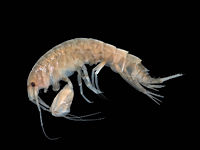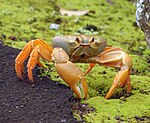Portal:Crustaceans
The Crustaceans Portal Crustaceans are a group of arthropods that are a part of the subphylum Crustacea (/krəˈsteɪʃə/), a large, diverse group of mainly aquatic arthropods including decapods (shrimps, prawns, crabs, lobsters and crayfish), seed shrimp, branchiopods, fish lice, krill, remipedes, isopods, barnacles, copepods, opossum shrimps, amphipods and mantis shrimp. The crustacean group can be treated as a subphylum under the clade Mandibulata. It is now well accepted that the hexapods (insects and entognathans) emerged deep in the Crustacean group, with the completed group referred to as Pancrustacea. The three classes Cephalocarida, Branchiopoda and Remipedia are more closely related to the hexapods than they are to any of the other crustaceans (oligostracans and multicrustaceans). The 67,000 described species range in size from Stygotantulus stocki at 0.1 mm (0.004 in), to the Japanese spider crab with a leg span of up to 3.8 m (12.5 ft) and a mass of 20 kg (44 lb). Like other arthropods, crustaceans have an exoskeleton, which they moult to grow. They are distinguished from other groups of arthropods, such as insects, myriapods and chelicerates, by the possession of biramous (two-parted) limbs, and by their larval forms, such as the nauplius stage of branchiopods and copepods. Most crustaceans are free-living aquatic animals, but some are terrestrial (e.g. woodlice, sandhoppers), some are parasitic (e.g. Rhizocephala, fish lice, tongue worms) and some are sessile (e.g. barnacles). The group has an extensive fossil record, reaching back to the Cambrian. More than 7.9 million tons of crustaceans per year are harvested by fishery or farming for human consumption, consisting mostly of shrimp and prawns. Krill and copepods are not as widely fished, but may be the animals with the greatest biomass on the planet, and form a vital part of the food chain. The scientific study of crustaceans is known as carcinology (alternatively, malacostracology, crustaceology or crustalogy), and a scientist who works in carcinology is a carcinologist. (Full article...) Selected article
Johngarthia lagostoma is a species of terrestrial crab that lives on Ascension Island and three other islands in the South Atlantic. It grows to a carapace width of 110 mm (4.3 in) on Ascension Island, where it is the largest native land animal. It exists in two distinct colour morphs, one yellow and one purple, with few intermediates. The yellow morph dominates on Ascension Island, while the purple morph is more frequent on Atol das Rocas. The species differs from other Johngarthia species by the form of the third maxilliped.
J. lagostoma lives in burrows among vegetation, at altitudes of up to 400 m (1,300 ft), emerging at night to feed on plant matter and occasionally on animals. From January to March there is an annual migration to the sea to release the planktonic larvae. The species was first described (as Gecarcinus lagostoma) by Henri Milne-Edwards in 1837 from material sent to him by the naturalists Jean René Constant Quoy and Joseph Paul Gaimard, collected by the French ship Astrolabe. Did you know?
Selected biographyEdward J. Miers F.Z.S. F.L.S. (1851–1930) was a British zoologist and curator of the crustacean collection at the Natural History Museum in London. He contributed to the scientific reports from the Challenger expedition of 1872–1876, and described 32 new genera and at least 260 new species and subspecies of decapod crustaceans, along with four genera and 72 new species in other orders. Miers published his Catalogue of the stalk- and sessile-eyed Crustacea of New Zealand in 1876 and revised the Plagusiinae, Hippidae, Majidae, Squillidae and Idoteidae in monographs dated 1878–1881. He also reported on the collections donated by the Admiralty from a number of voyages, including the survey of the coast of Japan by H.M.S. Sylvia (1870–1877), an expedition to view the Transit of Venus in Kerguelen and Rodrigues (1874–1875), a survey of the Galápagos Islands by H.M.S. Petrel, Novaya Zemlya by H.M.S. Isbjorn (1879), Baron Hermann-Maltzan's voyage to Gorée in 1881, and the voyages of H.M.S. Alert to Patagonia and the Strait of Magellan (1881–1882). The upheavals at his workplace and the quantity of work to be done may have taken their toll on Miers, and he was "completely prostrated with illness" for three months. Miers was still working on material from the Alert expedition, when six boxes containing the crabs from the Challenger expedition arrived, sent by John Murray. Describing these crabs would be Miers' largest taxonomic work, one which was published in 1886 as Report on the Brachyura collected by H. M. S. Challenger during the years 1873–1876 in 1886. Miers' honorarium for this work was £63 (60 guineas). Selected image Nototropis falcatus (formerly Atylus falcatus) is a species of amphipod from sandy bottoms in the North Atlantic and North Sea. General imagesThe following are images from various crustacean-related articles on Wikipedia.
Crustacean lists
SubcategoriesRelated portalsWikiProjectsAssociated WikimediaThe following Wikimedia Foundation sister projects provide more on this subject:
Discover Wikipedia using portals
|
- Portals with triaged subpages from June 2018
- All portals with triaged subpages
- All portals
- Portals with no named maintainer
- Random portal component with 21–25 available subpages
- Random portal component with 31–40 available subpages
- Random portal component with 11–15 available subpages
- Random portal component with 16–20 available image subpages
- Crustaceans
- Animal portals




















































